选修7 UNIT5 using language[下学期]
文档属性
| 名称 | 选修7 UNIT5 using language[下学期] | 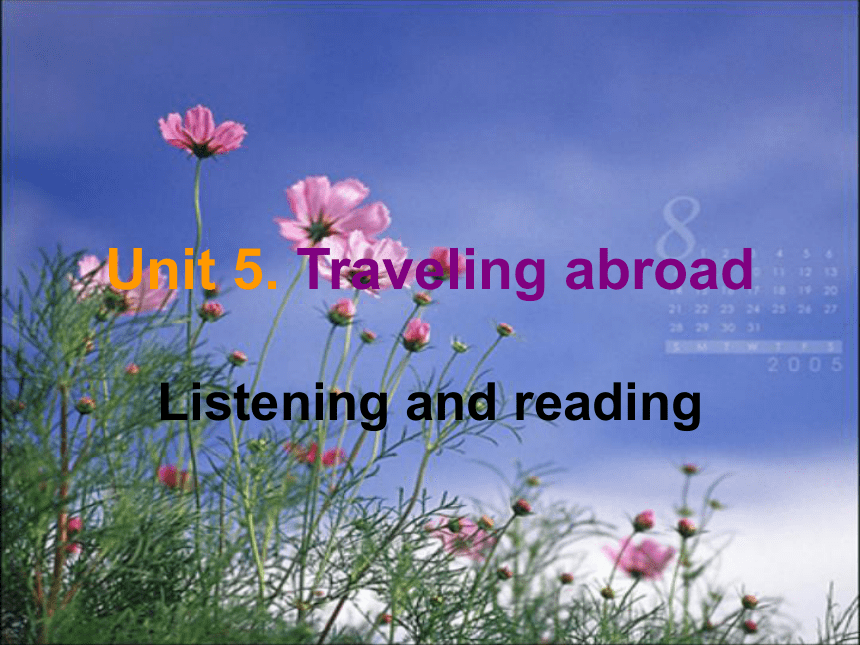 | |
| 格式 | rar | ||
| 文件大小 | 5.9MB | ||
| 资源类型 | 教案 | ||
| 版本资源 | 通用版 | ||
| 科目 | 英语 | ||
| 更新时间 | 2006-11-27 22:27:00 | ||
图片预览

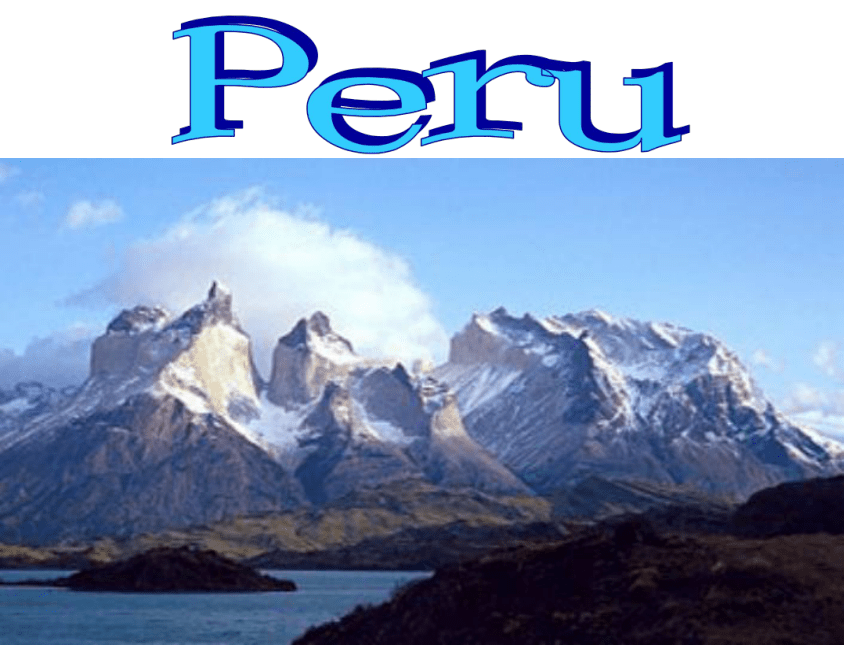
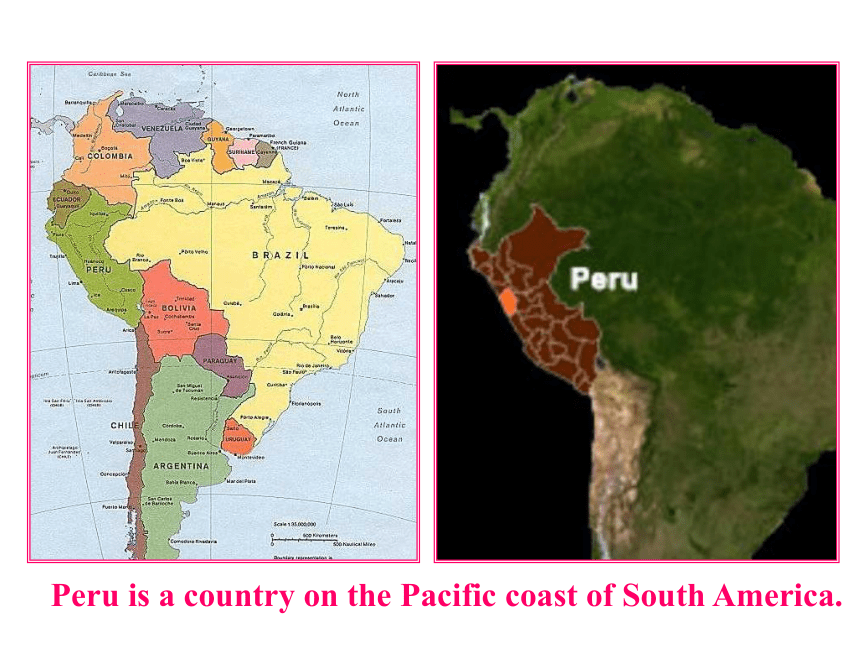
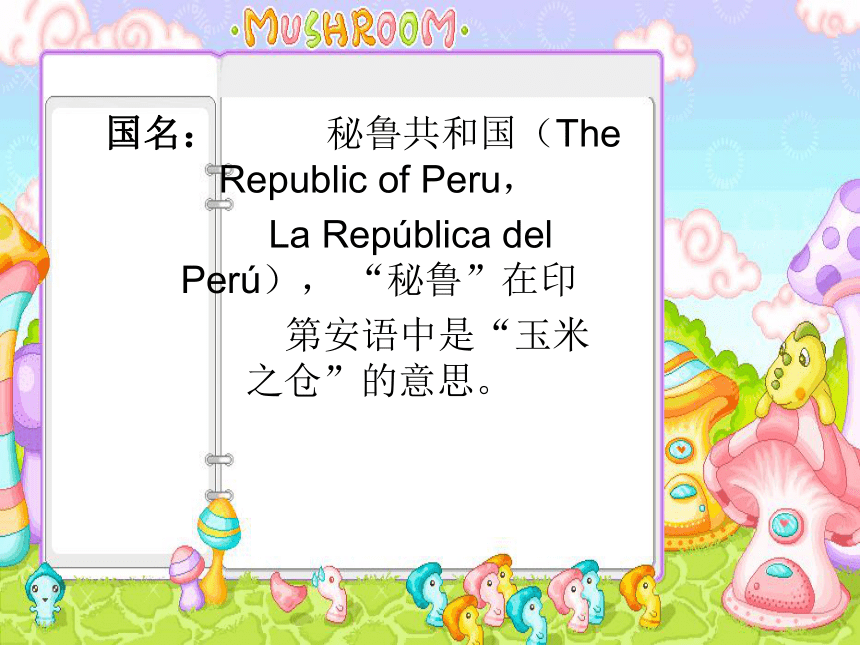
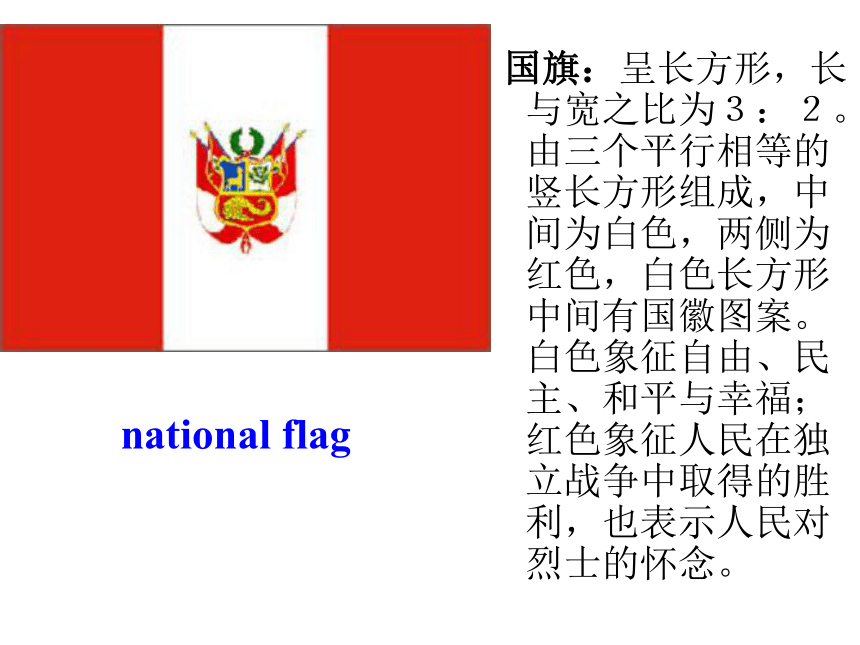
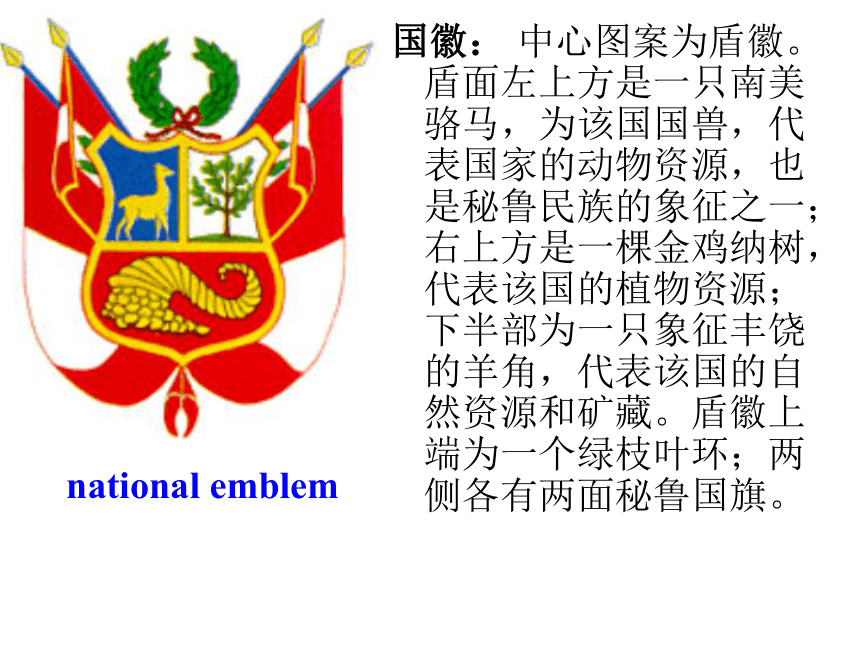

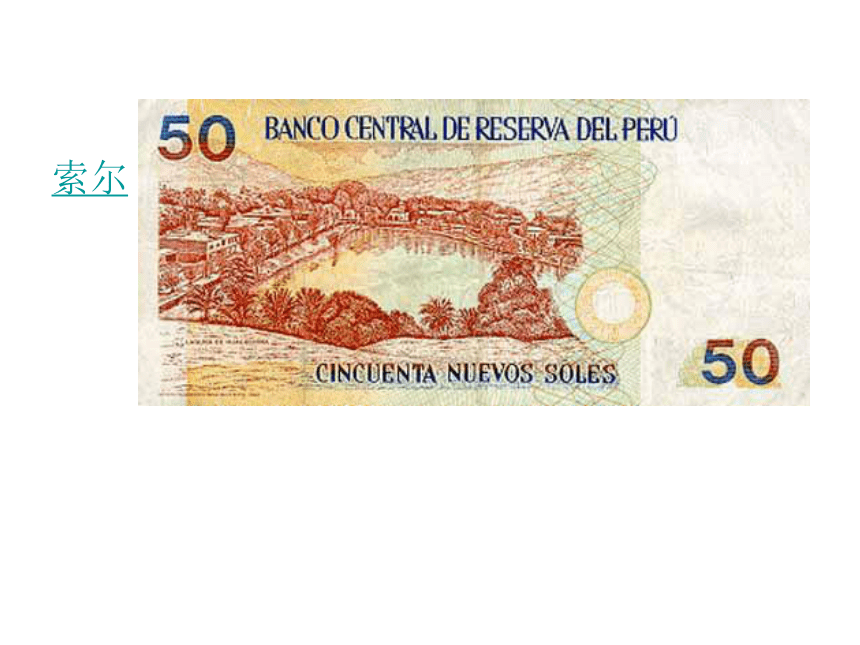


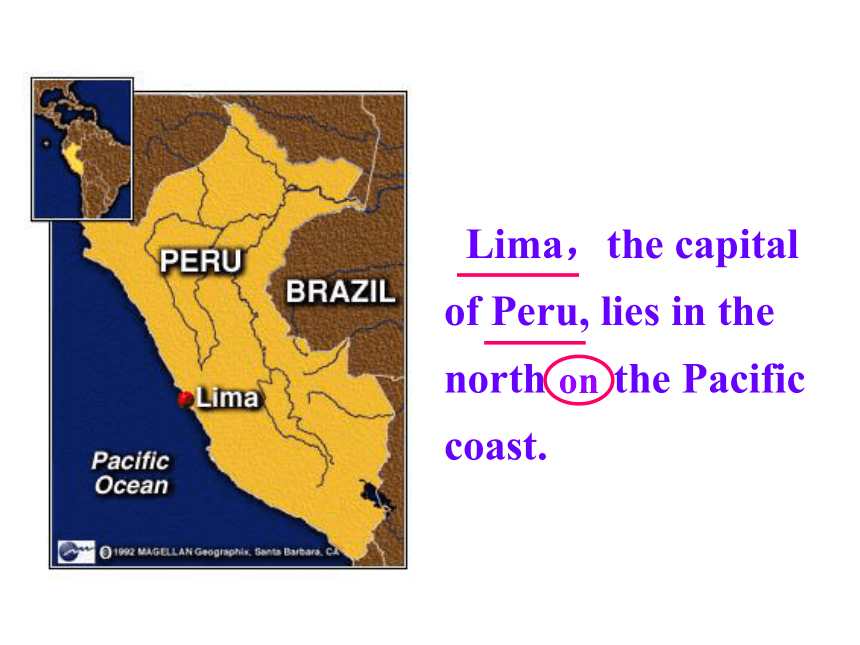
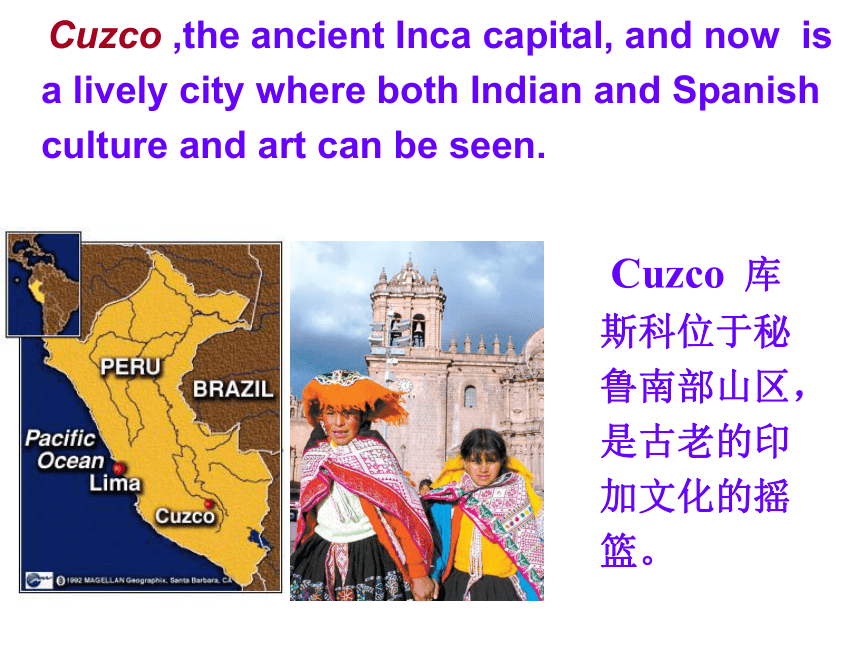
文档简介
课件70张PPT。Unit 5. Traveling abroadListening and readingPeru Peru is a country on the Pacific coast of South America.国名: 秘鲁共和国(The Republic of Peru,
La República del Perú), “秘鲁”在印
第安语中是“玉米 之仓”的意思。 ?国旗:呈长方形,长与宽之比为3:2。由三个平行相等的竖长方形组成,中间为白色,两侧为红色,白色长方形中间有国徽图案。白色象征自由、民主、和平与幸福;红色象征人民在独立战争中取得的胜利,也表示人民对烈士的怀念。 national flag国徽: 中心图案为盾徽。盾面左上方是一只南美骆马,为该国国兽,代表国家的动物资源,也是秘鲁民族的象征之一;右上方是一棵金鸡纳树,代表该国的植物资源;下半部为一只象征丰饶的羊角,代表该国的自然资源和矿藏。盾徽上端为一个绿枝叶环;两侧各有两面秘鲁国旗。 national emblem国花: 向日葵(sunflower)
国树:金鸡纳树
国兽:骆马
独立日:7月28日(1821年)
国庆日:7月28日(1821年) 索尔 第54届世界小姐秘鲁的选手玛丽亚-朱莉娅曼蒂拉-加辛尔最终获得本届冠军
Map of Peru Lima,the capital of Peru, lies in the north on the Pacific coast.on Cuzco ,the ancient Inca capital, and now is a lively city where both Indian and Spanish culture and art can be seen. Cuzco 库斯科位于秘鲁南部山区,是古老的印加文化的摇篮。利马唐人街入口处的中国牌楼。利马唐人街位于秘鲁首都利马市中心繁华地段的帕鲁罗街,是该国最大的华人聚居地费利佩城堡。 The Andes Mountains, runs parallel to the Pacific coast, and it is the longest mountains in the world.“the”用在江河湖海、山脉、
群岛、海峡、沙漠
等地理名词前。鲁印加古城库斯科的建城者帕查库特克的雕像及纪念碑 秘鲁印加遗址——Machu Picchu Peru LOCATION The Machupicchu archaeological complex is located in the department of Cusco, in the Urubamba province and district of Machupicchu. 安第斯山脉中的马丘比丘古城遗迹是目前保存最完好的印加古城之一,1983年被列入世界文化遗产名录
Lake Titicaca is the world's highest navigable lake and the center of a region where thousands of subsistence farmers eke out a living fishing in its icy waters, growing potatoes in the rocky land at its edge or herding llama and alpaca at altitudes that leave Europeans and North Americans gasping for air. It is also where traces of the rich Indian past still stubbornly cling, resisting in past centuries the Spanish conquistadors' aggressive campaign to erase Inca and preInca cultures and, in recent times, the lure of modernization. Cusco Sun Temple of QosqoBefore you listen, look at the map of South America. Find the cities of Lima and Cuzco and the Andes Mountains. And then discuss with others what you already know about PeruPre-listening City Hall of Lima City Hall of LimaCuzco The Andes Mountains The Andes Mountains Lake Titicaca Uros’ floating Island Amazon JungleListening Tick the things Lia likes doing. □ trying different kinds of food
□ going to historical sights
□ looking at wildlife
□ cycling
□ swimming □ visiting museums
□ learning about a country’s culture
□ going skiing
□ visiting places on her own
□ staying in expensive hotels√√√√1. Has Lia been to Peru before ?No!Have you been there before?
No, but I have heard a lot about it.2. Why does Lia prefer to travel independently ?She likes to look at things in her own time rather than being hurried from one place to another with a group.I like to be independent. I enjoy looking around at the things in my own time. I don’t like being hurried from one place to the next.3. Why does the travel agent advise her not to travel alone ?She might feel lonely. She might find it difficult because it’s her first visit.But you might find it difficult because it is your first time.4. Why does the travel agent think Cuzco will be a good place for Lia to go?Cuzco combines many of the things Lia likes doing. She can stay on her own hotel and take tours when she wants some company.I could travel by myself to Cuzco and stay in a hotel and when I wanted some company. 5. How will Lia know about tours from Cuzco ?The travel agent gives her a brochure.Here is a brochure that lists our tours from CuzcoListen again and complete the sentences.
I ____ _____ _____ independent.
But you _____ _____ _____ ________ because it’s your first time.
But I also _______ __________ .
You ______ _______ from Lima, the capital of Peru, to Cuzco.
We ______ ______ ______ into a hotel in Cuzco.liketobemightfinditdifficultlovemountainscould flycouldbookyouReading I----scanning& skimming (2m)Read the passage and answer the following questions: 1. Why is Cuzco popular with tourists?2. What is special about Lake Titicaca?3. What do you think the two official languages of Peru are?Reading 1. Why is Cuzco popular with tourists?
Cuzco is a popular tourist destination as it is close to the famous Inca ruins of the city of Machu Picchu. It’s a city where both Indian and Spanish culture and art can be seen. 2. What is special about Lake Titicaca?
Lake Titicaca is the highest lake in the world, and boats can travel on it. 3. What do you think the official languages of Peru are?
They are Indian and Spanish.4. Peru gained its independence from _______ in 1821.
A. England B. America
C. Spain D. Germany
C
语篇领悟
1. On which Tours can you visit the famous Inca ruins of the city of Machu Picchu?
A. Tour 1 and Tour 2
B. Tour 2 and Tour 3
C. Tour 1 and Tour 3
D. Tour 3 and Tour 4CGlance quickly through the brochure and then try to find out the answers to the following questions.小册子,背景材料2. If you want to get an opportunity to learn about the Uros Indian’s life, you can choose _________ .
A. Tour 1 B. Tour 2
C. Tour 3 D. Tour 4
3. You can ________ on Tour 4.
A. explore the jungle
B. enjoy some excellent food
C. buy some great souvenirs
D. Stay with a local family for a fully-day
BA尤若奥斯人的生活Which tours would best suit people who like an active holiday and don’t need first class accommodation?
Tour 1 and 4.
2.What kind of people would enjoy Tour 2?
People who enjoy learning about the culture and lifestyle of the country they are visiting, people who enjoy beautiful scenery but prefer to see it through the windows of a comfortable bus.
Read the brochure and
answer the questions3. On which tours do you visit Machu Picchu?
Tours1 and 3.
4. If you spent two weeks in and around Cuzco, which tour would be best to do last?
Tour 2 would be best to do last because it ends in Lima, the capital.Language points for Reading II1. Why does the travel agent advise her not to travel alone?advise sb. to do sth. 建议某人做某事,不定式作补语。
类似的动词还有: advise, allow, believe, command, consider, declare, encourage, find, forbid, imagine, know, like, order, permit, persuade, remind, request, require, suppose. advise与suggest两者的区别是: advise后面加somebody (not) to do...,而suggest后面必须加somebody (或者somebody's) doing...,当然两者都可以接宾语从句,注意宾语从句的动词形式必须是(should) (not) do…
e.g. I advise my father to stop smoking.
I suggest my father( father’s) stopping smoking.
I advise/suggest (that) my father (should) stop smoking.
2.scene, scenery, view, sight
scene 指“一眼可以浏览的风景”,但多半
包括其中的人物、动作和行为。(可数名词)
scenery 指该地区的“整个风景”,由多个
scene 构成的景色。(不可数名词)
view 指人从远处或高处以人的角度看到
的scenery的一部分。(可用作动词)
sight 风景、名胜,常用复数形式,指人
文景观。Language points1.There is a fine view of the mountain from our hotel window.
2.The Imperial Palace is one of the sights of China. 3. Hangzhou is world-famous for its beautiful scenery .
4.The scene of sunset was very beautiful.
You can always see a happy ______ of children playing in the garden.
A. scene B. scenery C. view D. eventA从我们旅馆的窗口可以看到秀丽的山景。故宫是中国名胜之一。日落的景色是非常美的。一个地方的总体外貌
(不可数名词)scene 指人们看到的包括人和人的活动的情景。3.parallel adj. 平行的,
parallel line 平行线
be parallel to/with 与…平行
The road and the canal are parallel to each other.Language points4. Peru has a wide variety of plants from desert grasses to vast areas of jungle, and abundant wildlife.
秘鲁有大量的植物,从沙漠里的小草到大面积的丛林,而且还有大量的野生动物。
abundant adj.
be abundant in 富于......,......很丰富
abundance n. 丰富
in abundance 大量,充裕
an abundance of 很多的......
abundant adj.大量的,丰富的,充实的
be abundant in 富有
a land abundant in minerals 矿产丰富的土地
The country is abundant in natural resources.
5. Cuzco is a lively city where both Indian and Spanish culture and art can be seen.
库斯科是一个可爱的城市,在那里随处可见印第安人和西班牙人的文化和艺术。
1) lively: 活泼生动的,有生气的,作定语和表语
a lively mind 头脑灵活的
2) alive:活着的,活的
作定语放于名词后,表语形容词=living
His dog is alive.
the greatest man alive
keep sth. alive
3) living活着的,逼真的+n.
the living writer
the livings
4) live: 现场直播的, 活着的
a live whale.
The football match will be broadcast live.
6.govern 统治,控制,支配
The country was governed
by the Queen.
The law of supply and
demand governs the prices
of goods.
government n.政府;内阁;管理
governor n.统治者,主管
7.destination n. 目的地,终点
arrive at/ reach one’s destination到达目的地
Tokyo is our final
destination. Speaking1 After listening to this text, you should know how to consult a travel agent for some necessary information about your tour. Now practice with your seatmate about how to get information from a travel agent. Form a dialogue.The following sentence patterns may help you.Can I help you?
Have you been there before?
Would you like to go by yourself or with a tour?
I like to be independent.
What do you suggest?
I enjoy…… I like …….. You could……..
I think I know the perfect place for you.
Here is a brochure that lists our tours from…..
How much the airfare to…….?
Speaking2Imagine you have ten days holiday. Then your group plans to spend eight days in and around Cuzco. Discuss which two tours you will like . You’d better use the following useful expressions:DiscussionSpeaking (group works)Words and expressions for you:
We would …
You might…
It would be possible to ….
It isn’t possible to …
…would be a perfect place for us .
I don’t think you’d enjoy …
… would probably suit us.
A: Among the four tours, which one would best suit people who like an active holiday and don’t need first class accommodation?
B: I think Tour 1 would be. Because in Tour 1 people can experience the jungle and its diverse wildlife close up during four-day walking tour, also can enjoy the wonderful scenery of mountain and the ancient ruins. A: If you spent two weeks in an around Cuzco, which tour would be best to do last?
B: Maybe Tour 2 would be best to do last. Because in Tour 2, after traveling we could return to Puno for our flight back to Lima.A: What kind of people would enjoy Tour 2?
B: I think Tour 2 would suit the people who like to travel by boat and like to get close to Indian culture and learn more about their life.
A: On which tours do you visit Machu Picchu (马丘比丘)?
B: We could visit Machu Picchu in Tour 1 and Tour 3.
La República del Perú), “秘鲁”在印
第安语中是“玉米 之仓”的意思。 ?国旗:呈长方形,长与宽之比为3:2。由三个平行相等的竖长方形组成,中间为白色,两侧为红色,白色长方形中间有国徽图案。白色象征自由、民主、和平与幸福;红色象征人民在独立战争中取得的胜利,也表示人民对烈士的怀念。 national flag国徽: 中心图案为盾徽。盾面左上方是一只南美骆马,为该国国兽,代表国家的动物资源,也是秘鲁民族的象征之一;右上方是一棵金鸡纳树,代表该国的植物资源;下半部为一只象征丰饶的羊角,代表该国的自然资源和矿藏。盾徽上端为一个绿枝叶环;两侧各有两面秘鲁国旗。 national emblem国花: 向日葵(sunflower)
国树:金鸡纳树
国兽:骆马
独立日:7月28日(1821年)
国庆日:7月28日(1821年) 索尔 第54届世界小姐秘鲁的选手玛丽亚-朱莉娅曼蒂拉-加辛尔最终获得本届冠军
Map of Peru Lima,the capital of Peru, lies in the north on the Pacific coast.on Cuzco ,the ancient Inca capital, and now is a lively city where both Indian and Spanish culture and art can be seen. Cuzco 库斯科位于秘鲁南部山区,是古老的印加文化的摇篮。利马唐人街入口处的中国牌楼。利马唐人街位于秘鲁首都利马市中心繁华地段的帕鲁罗街,是该国最大的华人聚居地费利佩城堡。 The Andes Mountains, runs parallel to the Pacific coast, and it is the longest mountains in the world.“the”用在江河湖海、山脉、
群岛、海峡、沙漠
等地理名词前。鲁印加古城库斯科的建城者帕查库特克的雕像及纪念碑 秘鲁印加遗址——Machu Picchu Peru LOCATION The Machupicchu archaeological complex is located in the department of Cusco, in the Urubamba province and district of Machupicchu. 安第斯山脉中的马丘比丘古城遗迹是目前保存最完好的印加古城之一,1983年被列入世界文化遗产名录
Lake Titicaca is the world's highest navigable lake and the center of a region where thousands of subsistence farmers eke out a living fishing in its icy waters, growing potatoes in the rocky land at its edge or herding llama and alpaca at altitudes that leave Europeans and North Americans gasping for air. It is also where traces of the rich Indian past still stubbornly cling, resisting in past centuries the Spanish conquistadors' aggressive campaign to erase Inca and preInca cultures and, in recent times, the lure of modernization. Cusco Sun Temple of QosqoBefore you listen, look at the map of South America. Find the cities of Lima and Cuzco and the Andes Mountains. And then discuss with others what you already know about PeruPre-listening City Hall of Lima City Hall of LimaCuzco The Andes Mountains The Andes Mountains Lake Titicaca Uros’ floating Island Amazon JungleListening Tick the things Lia likes doing. □ trying different kinds of food
□ going to historical sights
□ looking at wildlife
□ cycling
□ swimming □ visiting museums
□ learning about a country’s culture
□ going skiing
□ visiting places on her own
□ staying in expensive hotels√√√√1. Has Lia been to Peru before ?No!Have you been there before?
No, but I have heard a lot about it.2. Why does Lia prefer to travel independently ?She likes to look at things in her own time rather than being hurried from one place to another with a group.I like to be independent. I enjoy looking around at the things in my own time. I don’t like being hurried from one place to the next.3. Why does the travel agent advise her not to travel alone ?She might feel lonely. She might find it difficult because it’s her first visit.But you might find it difficult because it is your first time.4. Why does the travel agent think Cuzco will be a good place for Lia to go?Cuzco combines many of the things Lia likes doing. She can stay on her own hotel and take tours when she wants some company.I could travel by myself to Cuzco and stay in a hotel and when I wanted some company. 5. How will Lia know about tours from Cuzco ?The travel agent gives her a brochure.Here is a brochure that lists our tours from CuzcoListen again and complete the sentences.
I ____ _____ _____ independent.
But you _____ _____ _____ ________ because it’s your first time.
But I also _______ __________ .
You ______ _______ from Lima, the capital of Peru, to Cuzco.
We ______ ______ ______ into a hotel in Cuzco.liketobemightfinditdifficultlovemountainscould flycouldbookyouReading I----scanning& skimming (2m)Read the passage and answer the following questions: 1. Why is Cuzco popular with tourists?2. What is special about Lake Titicaca?3. What do you think the two official languages of Peru are?Reading 1. Why is Cuzco popular with tourists?
Cuzco is a popular tourist destination as it is close to the famous Inca ruins of the city of Machu Picchu. It’s a city where both Indian and Spanish culture and art can be seen. 2. What is special about Lake Titicaca?
Lake Titicaca is the highest lake in the world, and boats can travel on it. 3. What do you think the official languages of Peru are?
They are Indian and Spanish.4. Peru gained its independence from _______ in 1821.
A. England B. America
C. Spain D. Germany
C
语篇领悟
1. On which Tours can you visit the famous Inca ruins of the city of Machu Picchu?
A. Tour 1 and Tour 2
B. Tour 2 and Tour 3
C. Tour 1 and Tour 3
D. Tour 3 and Tour 4CGlance quickly through the brochure and then try to find out the answers to the following questions.小册子,背景材料2. If you want to get an opportunity to learn about the Uros Indian’s life, you can choose _________ .
A. Tour 1 B. Tour 2
C. Tour 3 D. Tour 4
3. You can ________ on Tour 4.
A. explore the jungle
B. enjoy some excellent food
C. buy some great souvenirs
D. Stay with a local family for a fully-day
BA尤若奥斯人的生活Which tours would best suit people who like an active holiday and don’t need first class accommodation?
Tour 1 and 4.
2.What kind of people would enjoy Tour 2?
People who enjoy learning about the culture and lifestyle of the country they are visiting, people who enjoy beautiful scenery but prefer to see it through the windows of a comfortable bus.
Read the brochure and
answer the questions3. On which tours do you visit Machu Picchu?
Tours1 and 3.
4. If you spent two weeks in and around Cuzco, which tour would be best to do last?
Tour 2 would be best to do last because it ends in Lima, the capital.Language points for Reading II1. Why does the travel agent advise her not to travel alone?advise sb. to do sth. 建议某人做某事,不定式作补语。
类似的动词还有: advise, allow, believe, command, consider, declare, encourage, find, forbid, imagine, know, like, order, permit, persuade, remind, request, require, suppose. advise与suggest两者的区别是: advise后面加somebody (not) to do...,而suggest后面必须加somebody (或者somebody's) doing...,当然两者都可以接宾语从句,注意宾语从句的动词形式必须是(should) (not) do…
e.g. I advise my father to stop smoking.
I suggest my father( father’s) stopping smoking.
I advise/suggest (that) my father (should) stop smoking.
2.scene, scenery, view, sight
scene 指“一眼可以浏览的风景”,但多半
包括其中的人物、动作和行为。(可数名词)
scenery 指该地区的“整个风景”,由多个
scene 构成的景色。(不可数名词)
view 指人从远处或高处以人的角度看到
的scenery的一部分。(可用作动词)
sight 风景、名胜,常用复数形式,指人
文景观。Language points1.There is a fine view of the mountain from our hotel window.
2.The Imperial Palace is one of the sights of China. 3. Hangzhou is world-famous for its beautiful scenery .
4.The scene of sunset was very beautiful.
You can always see a happy ______ of children playing in the garden.
A. scene B. scenery C. view D. eventA从我们旅馆的窗口可以看到秀丽的山景。故宫是中国名胜之一。日落的景色是非常美的。一个地方的总体外貌
(不可数名词)scene 指人们看到的包括人和人的活动的情景。3.parallel adj. 平行的,
parallel line 平行线
be parallel to/with 与…平行
The road and the canal are parallel to each other.Language points4. Peru has a wide variety of plants from desert grasses to vast areas of jungle, and abundant wildlife.
秘鲁有大量的植物,从沙漠里的小草到大面积的丛林,而且还有大量的野生动物。
abundant adj.
be abundant in 富于......,......很丰富
abundance n. 丰富
in abundance 大量,充裕
an abundance of 很多的......
abundant adj.大量的,丰富的,充实的
be abundant in 富有
a land abundant in minerals 矿产丰富的土地
The country is abundant in natural resources.
5. Cuzco is a lively city where both Indian and Spanish culture and art can be seen.
库斯科是一个可爱的城市,在那里随处可见印第安人和西班牙人的文化和艺术。
1) lively: 活泼生动的,有生气的,作定语和表语
a lively mind 头脑灵活的
2) alive:活着的,活的
作定语放于名词后,表语形容词=living
His dog is alive.
the greatest man alive
keep sth. alive
3) living活着的,逼真的+n.
the living writer
the livings
4) live: 现场直播的, 活着的
a live whale.
The football match will be broadcast live.
6.govern 统治,控制,支配
The country was governed
by the Queen.
The law of supply and
demand governs the prices
of goods.
government n.政府;内阁;管理
governor n.统治者,主管
7.destination n. 目的地,终点
arrive at/ reach one’s destination到达目的地
Tokyo is our final
destination. Speaking1 After listening to this text, you should know how to consult a travel agent for some necessary information about your tour. Now practice with your seatmate about how to get information from a travel agent. Form a dialogue.The following sentence patterns may help you.Can I help you?
Have you been there before?
Would you like to go by yourself or with a tour?
I like to be independent.
What do you suggest?
I enjoy…… I like …….. You could……..
I think I know the perfect place for you.
Here is a brochure that lists our tours from…..
How much the airfare to…….?
Speaking2Imagine you have ten days holiday. Then your group plans to spend eight days in and around Cuzco. Discuss which two tours you will like . You’d better use the following useful expressions:DiscussionSpeaking (group works)Words and expressions for you:
We would …
You might…
It would be possible to ….
It isn’t possible to …
…would be a perfect place for us .
I don’t think you’d enjoy …
… would probably suit us.
A: Among the four tours, which one would best suit people who like an active holiday and don’t need first class accommodation?
B: I think Tour 1 would be. Because in Tour 1 people can experience the jungle and its diverse wildlife close up during four-day walking tour, also can enjoy the wonderful scenery of mountain and the ancient ruins. A: If you spent two weeks in an around Cuzco, which tour would be best to do last?
B: Maybe Tour 2 would be best to do last. Because in Tour 2, after traveling we could return to Puno for our flight back to Lima.A: What kind of people would enjoy Tour 2?
B: I think Tour 2 would suit the people who like to travel by boat and like to get close to Indian culture and learn more about their life.
A: On which tours do you visit Machu Picchu (马丘比丘)?
B: We could visit Machu Picchu in Tour 1 and Tour 3.
